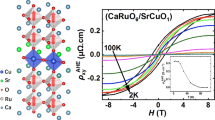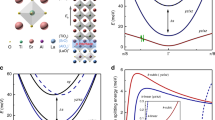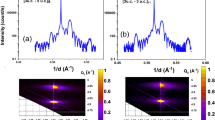Abstract
Advances in growth technology of oxide materials allow single atomic layer control of heterostructures. In particular delta doping, a key materials’ engineering tool in today’s semiconductor technology, is now also available for oxides. Here we show that a fully electric-field-tunable spin-polarized and superconducting quasi-2D electron system (q2DES) can be artificially created by inserting a few unit cells of delta doping EuTiO3 at the interface between LaAlO3 and SrTiO3 oxides1,2. Spin polarization emerges below the ferromagnetic transition temperature of the EuTiO3 layer (TFM = 6–8 K) and is due to the exchange interaction between the magnetic moments of Eu-4f and of Ti-3d electrons. Moreover, in a large region of the phase diagram, superconductivity sets in from a ferromagnetic normal state. The occurrence of magnetic interactions, superconductivity and spin–orbit coupling in the same q2DES makes the LaAlO3/EuTiO3/SrTiO3 system an intriguing platform for the emergence of novel quantum phases in low-dimensional materials.
This is a preview of subscription content, access via your institution
Access options
Subscribe to this journal
Receive 12 print issues and online access
$259.00 per year
only $21.58 per issue
Buy this article
- Purchase on Springer Link
- Instant access to full article PDF
Prices may be subject to local taxes which are calculated during checkout





Similar content being viewed by others
References
Ohtomo, A. & Hwang, H. Y. A high-mobility electron gas at the LaAlO3/SrTiO3 heterointerface. Nature 427, 423–426 (2004).
Reyren, N. et al. Superconducting interfaces between insulating oxides. Science 317, 1196–1199 (2007).
Thiel, S., Hammerl, G., Schmehl, A., Schneider, C. W. & Mannhart, J. Tunable quasi-two-dimensional electron gases in oxide heterostructures. Science 313, 1942–1946 (2006).
Cen, C., Thiel, S., Mannhart, J. & Levy, J. Oxide nanoelectronics on demand. Science 323, 1026–1030 (2009).
Caviglia, A. D. et al. Tunable Rashba spin–orbit interaction at oxide interfaces. Phys. Rev. Lett. 104, 126803 (2010).
Stornaiuolo, D. et al. Weak localization and spin–orbit interaction in side-gate field effect devices at the LaAlO3/SrTiO3 interface. Phys. Rev. B 90, 235426 (2014).
Richter, C. et al. Interface superconductor with gap behaviour like a high-temperature superconductor. Nature 502, 528–531 (2013).
Brinkman, A. et al. Magnetic effects at the interface between non-magnetic oxides. Nature Mater. 6, 493–496 (2007).
Li, L., Richter, C., Mannhart, J. & Ashoori, R. C. Coexistence of magnetic order and two-dimensional superconductivity. Nature Phys. 7, 762–766 (2011).
Bert, J. A. et al. Direct imaging of the coexistence of ferromagnetism and superconductivity at the LaAlO3/SrTiO3 interface. Nature Phys. 7, 767–771 (2011).
Pavlenko, N., Kopp, T., Tsymbal, E. Y., Sawatzky, G. A. & Mannhart, J. Magnetic and superconducting phases at the LaAlO3/SrTiO3 interface: The role of interfacial Ti 3d electrons. Phys. Rev. B 85, 020407 (2012).
Yu, L. & Zunger, A. A polarity-induced defect mechanism for conductivity and magnetism at polar–nonpolar oxide interfaces. Nature Commun. 5, 5118 (2014).
Lee, J. S. et al. Titanium dxy ferromagnetism at the LaAlO3/SrTiO3 interface. Nature Mater. 12, 703–706 (2013).
Salluzzo, M. et al. Origin of interface magnetism in BiMnO3/SrTiO3 and LaAlO3/SrTiO3 heterostructures. Phys. Rev. Lett. 111, 087204 (2013).
Breitschaft, M. et al. Two-dimensional electron liquid state at LaAlO3/SrTiO3 interfaces. Phys. Rev. B 81, 153414 (2010).
Moetakef, P. et al. Carrier-controlled ferromagnetism in SrTiO3 . Phys. Rev. X 2, 021014 (2012).
Bert, J. A. et al. Gate-tuned superfluid density at the superconducting LaAlO3/SrTiO3 interface. Phys. Rev. B 86, 060503(R) (2012).
Lee, J. H. et al. Optical band gap and magnetic properties of unstrained EuTiO3 films. Appl. Phys. Lett. 94, 212509 (2009).
Salluzzo, M. et al. Structural and electronic reconstructions at the LaAlO3/SrTiO3 interface. Adv. Mater. 25, 2333–2338 (2013).
Katsufuji, T. & Tokura, Y. Transport and magnetic properties of a ferromagnetic metal: Eu1−xRxTiO3 . Phys. Rev. B 60, R15021 (1999).
Garcia-Barriocanal, J. et al. Spin and orbital Ti magnetism at LaMnO3/SrTiO3 interfaces. Nature Commun. 1, 82 (2010).
Haverkort, M. et al. Determination of the orbital moment and crystal-field splitting in LaTiO3 . Phys. Rev. Lett. 94, 056401 (2005).
Banerjee, S., Erten, O. & Randeria, M. Ferromagnetic exchange, spin–orbit coupling and spiral magnetism at the LaAlO3/SrTiO3 interface. Nature Phys. 9, 626–630 (2013).
De Luca, G. M. et al. Transport properties of a quasi-two-dimensional electron system formed in LaAlO3/EuTiO3/SrTiO3 heterostructures. Phys. Rev. B 89, 224413 (2014).
Joshua, A., Pecker, S., Ruhman, J., Altman, E. & Ilani, S. A universal critical density underlying the physics of electrons at the LaAlO3/SrTiO3 interface. Nature Commun. 3, 1129 (2012).
Takahashi, K., Onoda, M., Kawasaki, M., Nagaosa, N. & Tokura, Y. Control of the anomalous Hall effect by doping in Eu1−xLaxTiO3 thin films. Phys. Rev. Lett. 103, 057204 (2009).
Nagaosa, N., Sinova, J., Onoda, S., MacDonald, A. H. & Ong, N. P. Anomalous Hall effect. Rev. Mod. Phys. 82, 1539–1592 (2010).
Joshua, A., Ruhman, J. & Pecker, S. Gate-tunable polarized phase of two-dimensional electrons at the LaAlO3/SrTiO3 interface. Proc. Natl Acad. Sci. USA 110, 9633–9638 (2013).
Caviglia, A. D. et al. Electric field control of the LaAlO3/SrTiO3 interface ground state. Nature 456, 624–627 (2008).
Nakosai, S., Tanaka, Y. & Nagaosa, N. Topological superconductivity in bilayer Rashba system. Phys. Rev. Lett. 108, 147003 (2012).
Acknowledgements
We received funding from the Ministero dell’Istruzione, dell’Università e della Ricerca for the FIRB 2012 project HybridNanoDev (Grant No. RBFR1236VV), FIRB 2011 project ‘Oxides at the nanoscale: multifunctionality and applications’ (Grant No. RBAP115AYN) and for the PRIN 2010-11 project (Grant No. PRIN 2010-11–OXIDE). The X-ray absorption measurements were performed on the EPFL/PSI X-Treme beamline at the Swiss Light Source, Paul Scherrer Institut, Villigen, Switzerland. The research of C.C. was supported by the US Department of Energy, Basic Energy Sciences, Materials Sciences and Engineering Division. The research of B.J. was supported by CNRS under PICS-0754.
Author information
Authors and Affiliations
Contributions
The samples were prepared by E.D.G., G.M.D.L. and F.M.G., and were characterized by R.D.C., I.P. and D.S. C.C. performed the STEM and EELS experiments and interpreted the data. G.M.D.L., D.Marrè, C.P., S.R. and M.S. carried out the X-ray spectroscopy experiments. M.S., S.R. and G.G. analysed the X-ray spectroscopy data. D.S. was responsible for transport measurements under field effect and data analysis, with D.Massarotti and F.T. for dilution temperatures measurements, and with B.J. for the magneto-transport characterizations and analysis. All the authors contributed to the interpretation of the data. M.S. and D.S. wrote the manuscript. The project was coordinated by M.S.
Corresponding authors
Ethics declarations
Competing interests
The authors declare no competing financial interests.
Supplementary information
Supplementary Information
Supplementary Information (PDF 2557 kb)
Rights and permissions
About this article
Cite this article
Stornaiuolo, D., Cantoni, C., De Luca, G. et al. Tunable spin polarization and superconductivity in engineered oxide interfaces. Nature Mater 15, 278–283 (2016). https://doi.org/10.1038/nmat4491
Received:
Accepted:
Published:
Issue Date:
DOI: https://doi.org/10.1038/nmat4491
This article is cited by
-
Tuning of the magnetotransport properties of a spin-polarized 2D electron system using visible light
Scientific Reports (2023)
-
Coexistence and coupling of ferroelectricity and magnetism in an oxide two-dimensional electron gas
Nature Physics (2023)
-
Orbital selective switching of ferromagnetism in an oxide quasi two-dimensional electron gas
npj Quantum Materials (2022)
-
High-temperature superconductivity and its robustness against magnetic polarization in monolayer FeSe on EuTiO3
npj Quantum Materials (2021)
-
Gate-tuned anomalous Hall effect driven by Rashba splitting in intermixed LaAlO3/GdTiO3/SrTiO3
Scientific Reports (2021)



